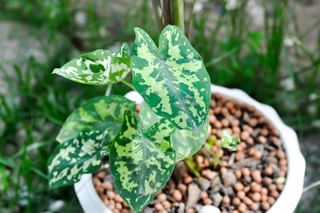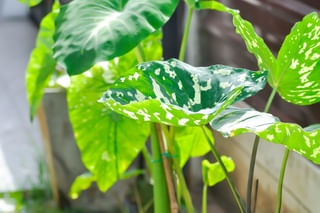Fun facts about the Caladium Hilo Beauty
Known for its striking green leaves adorned with white spots, the Caladium Hilo Beauty is more than just a visual delight in any garden. This plant has an intriguing history and some fascinating characteristics that make it a favorite among plant enthusiasts. Here are some fun facts that highlight the unique allure of the Caladium Hilo Beauty:
Natural habitat
Caladium plants, including the Hilo Beauty, are native to tropical regions of the Americas and Southeast Asia. They thrive in the warm, humid conditions of rainforests.
Name origin
The name "Caladium" is derived from the Malay word "keladi, which means "plant with edible roots". The name "Hilo" is a place in Hawaii which is why many believe this was why the plant took on the name "Caladium Hilo Beauty." While the name of the plant would make you think it's edible, it's not. It's quite toxic when eaten.
Variety of colors
Caladiums are renowned for their spectacular range of colors and patterns. The Hilo Beauty, specifically, features striking green leaves with yellow spots, resembling a painter's palette.
Heart-shaped leaves
The heart-shaped leaves of many Caladium varieties, including Hilo Beauty, symbolize love and admiration in floral symbolism. This makes them popular as decorative plants in romantic settings.
Seasonal dormancy
Caladiums are tuberous plants that go dormant in the winter. During this time, they lose their leaves and rest until the growing season resumes. This dormancy helps them survive in their native tropical climates where dry seasons can occur.
Popular in victorian gardens
Caladiums gained popularity in the Victorian era, especially in Europe, where they were prized for their exotic appearance and used extensively in conservatories and garden displays.
Medical research
While not widely known, some species within the Araceae family (to which Caladium belongs) have been studied for their potential medicinal properties, though Caladium itself is primarily ornamental.
Toxicity warning
All parts of the Caladium plant contain calcium oxalate crystals, making them toxic if ingested. This fact underscores the importance of keeping these plants away from pets and children.
Symbol of transformation
In some cultures, due to their dramatic seasonal transformation (from dormancy to full bloom), Caladiums are seen as symbols of change and transformation.
Hilo Beauty's popularity
The Hilo Beauty variety has become especially popular in recent years among houseplant enthusiasts due to its unique speckled foliage, which stands out among other more common Caladiums.
Didn't find what you were looking for?
We have resources about other plants and plant-related topics as well.
Perhaps these resources contain the information you're looking for.
I've written a lot of guides about all kinds of aspects of taking care of plants, but I could've missed that specific topic you were looking for. If that's the case, you can request a plant guide. This way I can provide you with the information you need quickly and you won't have to wonder if you're taking care of your plant properly anymore.


